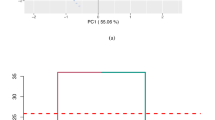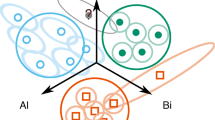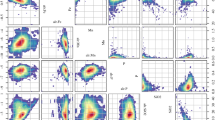Abstract
Geologists may want to classify compositional data and express the classification as a map. Regionalized classification is a tool that can be used for this purpose, but it incorporates discriminant analysis, which requires the computation and inversion of a covariance matrix. Covariance matrices of compositional data always will be singular (noninvertible) because of the unit-sum constraint. Fortunately, discriminant analyses can be calculated using a pseudo-inverse of the singular covariance matrix; this is done automatically by some statistical packages such as SAS. Granulometric data from the Darss Sill region of the Baltic Sea is used to explore how the pseudo-inversion procedure influences discriminant analysis results, comparing the algorithm used by SAS to the more conventional Moore–Penrose algorithm. Logratio transforms have been recommended to overcome problems associated with analysis of compositional data, including singularity. A regionalized classification of the Darss Sill data after logratio transformation is different only slightly from one based on raw granulometric data, suggesting that closure problems do not influence severely regionalized classification of compositional data.
Similar content being viewed by others
REFERENCES
Aitchison, J., 1986, The statistical analysis of compositional data: Chapman and Hall, London, 416 p.
Bohling, G. C., 1997, GSLIB-style programs for discriminant analysis and regionalized classification: Computers & Geosciences, in press.
Davis, J. C., Harff, J., Lemke, W., Olea, R. A., Tauber, F., Bohling, G. C., and Di Zhou, 1995, Analysis of sedimentary facies by regionalized classification: Kansas Geol. Survey Open-file Rept. 95–4, 28 p.
Golub, G. H., and Van Loan, C. F., 1989, Matrix computations (2nd ed.): The Johns Hopkins Univ. Press, Baltimore, 642 p.
Harff, J., and Davis, J. C., 1990. Regionalization in geology by multivariate classification: Math. Geology, v. 22,no. 5, p. 573–588.
Lemke, W., Kuijpers, A., Hoffmann, G., Milkert, D., and Atzler, R. 1994, The Darss Sill, hydrographic threshold in the southwestern Baltic: Late Quaternary geology and recent sediment dynamics: Continental Shelf Research, v. 14,no. 7/8, p. 847–870.
McLachlan, G. J., 1992, Discriminant analysis and statistical pattern recognition: John Wiley & Sons, New York, 526 p.
Press, W. H., Teukolsky, S. A., Vetterling, W. T., and Flannery, B. P. 1992, Numerical recipes in FORTRAN: the art of scientific computing (2nd ed.): Cambridge Univ. Press, Cambridge, 963 p.
Sampson, R. J., 1988, Surface III® User's manual: Kansas Geol. Survey, unpaginated.
SAS Institute Inc., 1989, SAS/STAT® User's guide, Version 6, (4th ed.), v. 2: SAS Institute Inc., Cary, North Carolina, unpaginated.
Author information
Authors and Affiliations
Rights and permissions
About this article
Cite this article
Bohling, G.C., Davis, J.C., Olea, R.A. et al. Singularity and Nonnormality in the Classification of Compositional Data. Mathematical Geology 30, 5–20 (1998). https://doi.org/10.1023/A:1021705120065
Issue Date:
DOI: https://doi.org/10.1023/A:1021705120065




